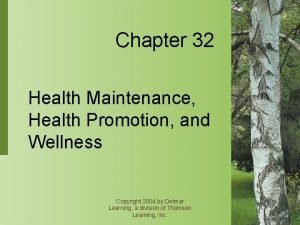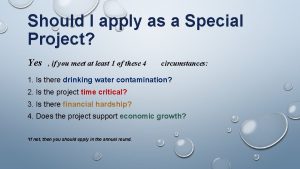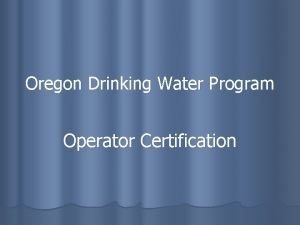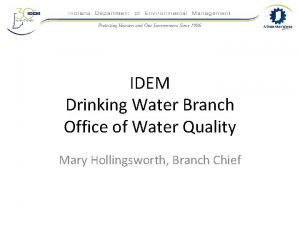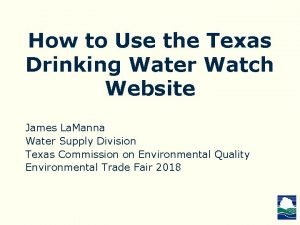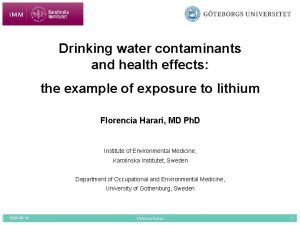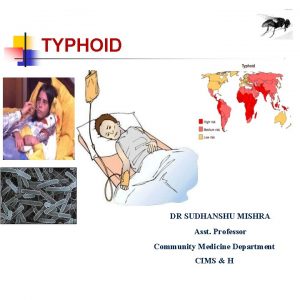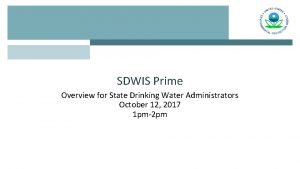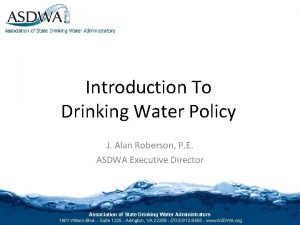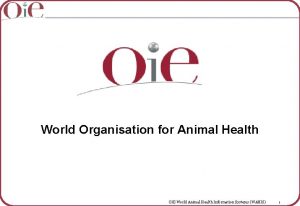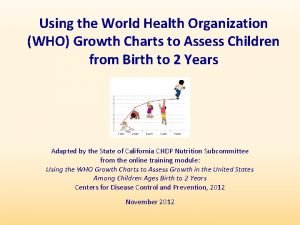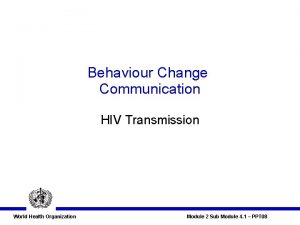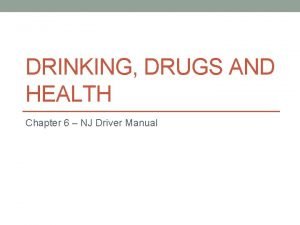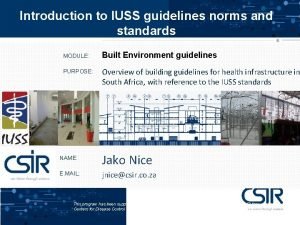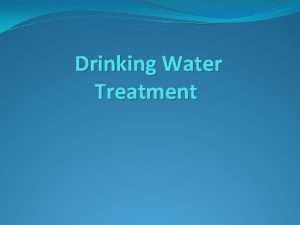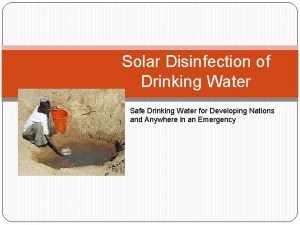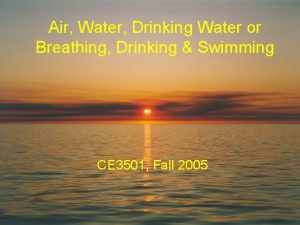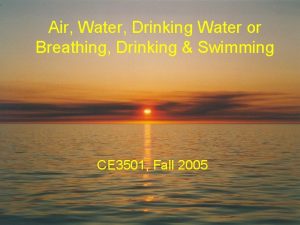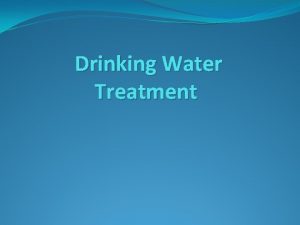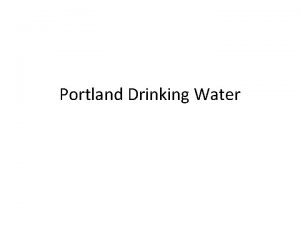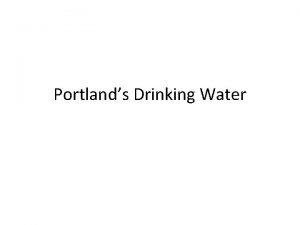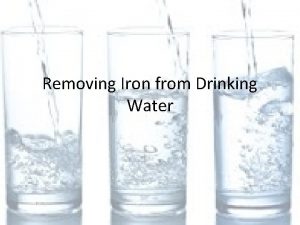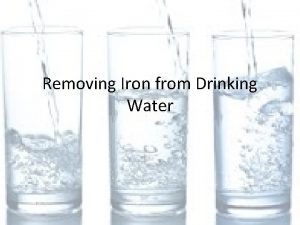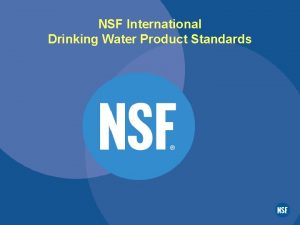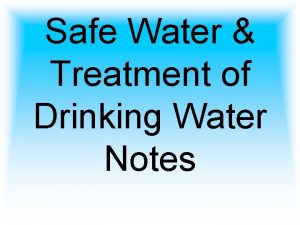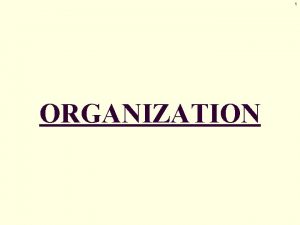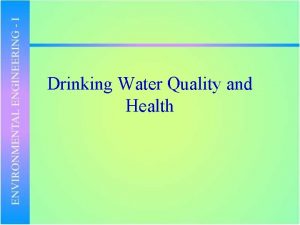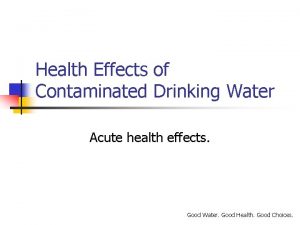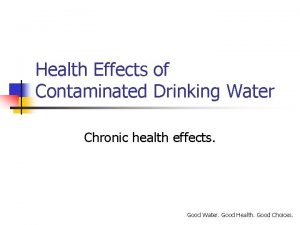The World Health Organization Drinking Water Guidelines for

























- Slides: 25

The World Health Organization Drinking Water Guidelines for Toxic Inorganic Substances and Public Health in Bangladesh, India, and Myanmar Seth Frisbie, Ph. D. Bibudhendra Sarkar, Ph. D. Hannah Dustin, B. S. Kelly Bradshaw, B. S. Jeffrey Defelice, B. S. Erika Mitchell, Ph. D. Donald Maynard, P. E. Thomas Bacquart, Ph. D. George Springston, M. S. Laurie Grigg, Ph. D. Copyright © 2016 Seth H. Frisbie, Ph. D. All rights reserved.

A History of Drinking Water in Bangladesh • Rivers, ponds, and dug wells were the only practical source of drinking water for about 3, 000 years until the 1970 s. • A massive cholera outbreak began in 1963. (Photograph by Dhaka Hospital) • Many premature deaths were caused by drinking surface water. • The life expectancy during the mid-1960 s was only 46 years.

A History of Drinking Water in Bangladesh • Approximately 10, 000 tubewells have been installed since 1971 to supply safe drinking water. • Within 1 generation the population changed from drinking surface water to drinking groundwater. • By 2000, approximately 97% of Bangladeshis drank tubewell water. (Photograph by Steven Brace, 1995)

A History of Drinking Water in Bangladesh • The symptoms of chronic arsenic (As) poisoning from drinking water usually take 5 to 20 years to manifest. • Chronic As poisoning from drinking tubewell water was first diagnosed in 1993. Keratosis of the feet Blackfoot disease Keratosis of the palms (Photograph by Dhaka Community Hospital and Richard Wilson, 2002) Melanosis of the chest

A History of Drinking Water in Bangladesh • The first national-scale map of As concentration in Bangladesh’s tubewell water was made in 1997. • Approximately 75, 000 Bangladeshis are at risk of death from skin, bladder, liver, and lung cancers caused by chronic As poisoning. • The source of As is geological. Map of As concentration (mg/L).

Estimated number of Bangladeshis drinking water with metal concentrations above WHO guidelines. Metal Carcinogenic Potential WHO Guideline (µg/L) Percent of Bangladesh’s Area Exceeding WHO Guideline As Mn Pb Ni Cr Known carcinogen Noncarcinogen Possible carcinogen Probable carcinogen Noncarcinogen 10 400 10 20 50 49 60 3 <1 <1 Number of Bangladeshis Drinking Unsafe Water a 75, 000 92, 000 4, 600, 000 < 1, 500, 000 Assuming Bangladesh has 158, 570, 535 people (July 2011 est. ) and 97% of its population drinks well water. a • Tens of millions of Bangladeshis are drinking water that exceeds WHO health-based guidelines for As, manganese (Mn), lead (Pb), nickel (Ni), and chromium (Cr). • Boron (B), barium (Ba), molybdenum (Mo), and uranium (U) have also been found above WHO health-based guidelines in Bangladesh.

The Discovery of Multiple Toxic Elements in West Bengal’s Drinking Water • The deep well water from neighboring West Bengal, India has unsafe concentrations of As, B, fluoride (F-), Mn, and possibly thorium (Th).

• • • The Discovery of Multiple Toxic Elements in Myanmar’s Drinking Water The deep well water from neighboring Myanmar has unsafe concentrations of As, F-, Mn, and U. This rapid switch to deep well water is exposing hundreds of millions of people in south Asia to unsafe concentrations of metals. This has been called the largest mass poisoning in history.

The World Health Organization • In the most recent edition of Guidelines for Drinking-water Quality (2011), the World Health Organization (WHO) made its drinking-water guidelines less restrictive or did not establish guidelines for 9 chemicals that can cause adverse health effects and that are commonly found in drinking water. • In contrast, the WHO did not make any guidelines more restrictive or establish any new guidelines for other chemicals from this family.

• • • The World Health Organization WHO guidelines are not regulations, but may be used by governments or other stakeholders for setting local standards. Some countries, especially those with limited resources, use WHO guidelines as de facto standards. Therefore, these guidelines often directly affect the most disadvantaged populations.

• • • The World Health Organization and Manganese The 400 µg/L drinking-water guideline for manganese (Mn) was discontinued by the WHO with the assertion that since “this health-based value is well above concentrations of manganese normally found in drinking-water, it is not considered necessary to derive a formal guideline value”. However, over 50 countries have drinking-water supplies with manganese above 400 µg/L. In Bangladesh alone, over 90, 000 people are drinking water with manganese above 400 µg/L. (Image by Theodore Gray)

• • The World Health Organization and Molybdenum Similarly, the 70 µg/L drinking-water guideline for molybdenum (Mo) was discontinued by the WHO with the assertion that molybdenum “occurs in drinking-water at concentrations well below those of health concern”; therefore, “it is not considered necessary to set a formal guideline value”. However, the WHO previously stated that in a “survey of 380 finished water samples from across the USA, 29. 9% contained measurable concentrations of molybdenum, with a mean of 85. 9 µg/litre and a range of 3 -1024 µg/litre”. (Image by Theodore Gray)

• • • The World Health Organization and Nitrite The 200 µg/L drinking-water guideline for chronic or long-term exposure to nitrite (NO 2 -) was suspended. However, the WHO recommended that the “average exposures [of nitrite] over time should not exceed about [200 µg/L]”. Given this recommendation, the decision to suspend the 200 µg/L guideline seems inconsistent. (Image by Theodore Gray)

• • • The World Health Organization and Aluminum The WHO stated that a 900 µg/L drinking-water guideline for aluminum (Al) “could be derived”; however, this guideline was not established. According to the WHO, aluminum is commonly found in drinking water at concentrations above 900 µg/L. Aluminum is the third most abundant element in the earth’s crust. (Image by Theodore Gray)

The World Health Organization and Boron • The WHO relaxed (increased) the drinking-water guideline for boron (B) from 500 µg/L to 2, 400 µg/L. • However, at least part of this increase was due to a rounding error. (Image by Theodore Gray)

• • The World Health Organization and Nickel The WHO relaxed (increased) the drinking-water guideline for nickel (Ni) from 20 µg/L to 70 µg/L. The former 20 µg/L guideline protects against adverse kidney, liver, and reproductive effects from chronic or long-term exposure to nickel. In contrast, the current 70 µg/L guideline protects against skin eczema from a less likely acute or short-term exposure to nickel. This change was justified by an unpublished, industry-funded study done by a commercial laboratory; an interlibrary loan request for this study was declined by the industry group. (Image by Theodore Gray)

• • • The World Health Organization and Uranium The WHO relaxed (increased) the drinking-water guideline for uranium (U) from 2 µg/L to 15 µg/L, and then from 15 µg/L to 30 µg/L. The most recent increase was calculated using a “no-effect group” with “no evidence of renal damage”. However, this nominal “no-effect group” was associated with statistically significant increases in diastolic blood pressure, systolic blood pressure, glucose excretion in urine, calcium fractional excretion, phosphate fractional excretion, and diuresis. (Image by Theodore Gray)

• • The World Health Organization and Mercury The WHO relaxed (changed) the drinking-water guideline for mercury (Hg) from 1 µg/L of total mercury to 6 µg/L of inorganic mercury. The former 1 µg/L guideline was based on the toxicity of methylmercury, an organic and highly toxic form of mercury found in the environment. The revised guideline is applied only to inorganic mercury. This change did not take into account important research published during the last 10 years. (Image by Theodore Gray)

• • • The World Health Organization and Selenium Similarly, the WHO relaxed (increased) the drinking -water guideline for selenium (Se) from 10 µg/L to 40 µg/L. However, this increase did not take into account important research on selenium toxicity and children that was published during the last 15 years. As a result, the current 40 µg/L drinking-water guideline for selenium does not protect children. (Image by Theodore Gray)

A Challenge for Drinking Water Scientists Abundance of elements in the earth’s crust. Elements with WHO drinking water guidelines are white. No. Ele. ppm 1 2 3 4 5 6 7 8 9 10 11 12 13 14 15 16 17 18 19 O Si Al Fe Ca Mg Na K Ti H P Mn F Ba Sr S C Zr V 455, 000 272, 000 83, 000 62, 000 46, 600 27, 640 22, 700 18, 400 6, 320 1, 520 1, 120 1, 060 544 390 384 340 180 162 136 20 21 22 23 24 25 26 27 28 29 30 31 32 33 a 33 b 35 36 37 38 Cl Cr Ni Rb Zn Cu Ce Nd La Y Co Sc Nb N Ga Li Pb Pr B 126 122 99 78 76 68 66 40 35 31 29 25 20 19 19 18 13 9. 1 9 39 40 41 42 43 44 45 46 47 48 a 48 b 50 51 52 53 54 55 a 55 b 55 c Th Sm Gd Er Yb Hf Cs Br U Sn Eu Be As Ta Ge Ho Mo W Tb 8. 1 7. 0 6. 1 3. 5 3. 1 2. 8 2. 6 2. 5 2. 3 2. 1 2 1. 8 1. 7 1. 5 1. 3 1. 2 58 59 60 61 62 63 64 a 64 b 66 67 68 69 70 71 72 a 72 b 74 75 a 75 b Tl Tm I In Sb Cd Ag Hg Se Pd Pt Bi Os Au Ir Te Re Ru Rh 0. 7 0. 5 0. 46 0. 24 0. 2 0. 16 0. 08 0. 05 0. 01 0. 008 0. 005 0. 004 0. 001 0. 0007 0. 0001 • Only 14 of 76 (18%) elements in the earth’s crust have a WHO drinking water guideline. Many of the remaining elements are toxic and commonly found in groundwater. More guidelines are needed.

A Second Challenge for Drinking Water Scientists 50, 000 ng/L The maximum allowable concentration of As in drinking water set by the governments of most developing counties 10, 000 ng/L The maximum allowable concentration of As in drinking water recommended by the WHO and set by the governments of most developed counties 7, 000 ng/L The detection limit for measuring As in drinking water by the arsenomolybdate method 170 ng/L Causes an unacceptable risk of death from skin cancer, according to the WHO 10 ng/L Causes an unacceptable risk of death from all cancers, according to the Harvard School of Public Health

A Third Challenge for Drinking Water Scientists The range of uranium concentrations in drinking water samples from various states, cities, and regions in India (Bajwaa, et al. 2015). State, City, or Region of India Delhi Ghaziabad Himachal Pradesh, Bilaspur Himachal Pradesh, Chamba Himalayas Hyderabad Jhansi Kanpur Karnataka, Kolar Maharashtra Punjab, Amritsar Punjab, Bhatinda Punjab, Malwa Uttar Pradesh West Bengal Range of Uranium Concentration (μg/L) 2. 2 – 8. 8 4. 2 – 11. 4 0. 1 – 4. 6 0. 3 – 6. 8 1. 1 – 35. 8 0. 6 – 82. 0 0. 9 – 6. 4 3. 3 – 9. 1 0. 3 – 1, 442. 9 0. 03 – 7. 8 0. 5 – 579 3. 2 – 45. 6 11. 7 – 113. 7 5. 4 – 43. 4 1. 4 – 19. 2 1. 3 – 13. 2

Sources Primary: • Frisbie, S. H. , D. M. Maynard, and B. A. Hoque. 1999. The nature and extent of arsenic-affected drinking water in Bangladesh. In Metals and Genetics. Ed. by B. Sarkar. Plenum Publishing Company. New York, NY. Pp. 67 -85. • Frisbie, S. H. , R. Ortega, D. M. Maynard, and B. Sarkar. 2002. The concentrations of arsenic and other toxic elements in Bangladesh’s drinking water. Environmental Health Perspectives. 110(11): 1147 -1153. • Frisbie, S. H. , E. J. Mitchell, D. M. Maynard, R. Ortega, and B. Sarkar. 2004. Arsenic and multimetal environmental contamination in Bangladesh. Clinical Biochemistry. 37: 1126. • Frisbie, S. H. , E. J. Mitchell, A. Z. Yusuf, M. Y. Siddiq, R. E. Sanchez, R. Ortega, D. M. Maynard, and B. Sarkar. 2005. The development and use of an innovative laboratory method for measuring arsenic in drinking water from western Bangladesh. Environmental Health Perspectives. 113(9): 1196 -1204. • Frisbie, S. H. , E. J. Mitchell, L. J. Mastera, D. M. Maynard, A. Z. Yusuf, M. Y. Siddiq, R. Ortega, R. K. Dunn, D. S. Westerman, T. Bacquart, and B. Sarkar. 2009. Public health strategies for western Bangladesh that address the arsenic, manganese, uranium and other toxic elements in their drinking water. Environmental Health Perspectives. 117(3): 410– 416.

Sources Primary: • Mitchell, E. J. , S. H. Frisbie, and B. Sarkar. 2011. Exposure to multiple metals from groundwater—a global crisis: Geology, climate change, health effects, testing, and mitigation. Metallomics. 3(9): 874 -908. • Bacquart, T. , K. Bradshaw, S. H. Frisbie, E. J. Mitchell, G. Springston, J. Defelice, H. Dustin, and B. Sarkar. 2012. A survey of arsenic, manganese, boron, thorium, and other toxic metals in the groundwater of a West Bengal, India neighbourhood. Metallomics. 7(4): 653– 659. • Frisbie, S. H. , E. J. Mitchell, H. Dustin, D. M. Maynard, and B. Sarkar. 2012. World Health Organization discontinues its drinking-water guideline for manganese. Environmental Health Perspectives. 120(6): 775 -778. • Frisbie, S. H. , E. J. Mitchell, and B. Sarkar. 2013. World Health Organization increases its drinking-water guideline for uranium. Environmental Science: Processes & Impacts. 15: 1817– 1823. • Bacquart, T. , S. H. Frisbie, E. J. Mitchell, L. Grigg, C. Cole, C. Small, and B. Sarkar. 2015. Multiple inorganic toxic substances contaminating the groundwater of Myingyan Township, Myanmar: Arsenic, manganese, fluoride, iron, and uranium. Science of the Total Environment. 517: 232– 245. • Frisbie, S. H. , E. J. Mitchell, and B. Sarkar. 2015. Urgent need to reevaluate the latest World Health Organization guidelines for toxic inorganic substances in drinking water. Environmental Health. 14: 63.

Sources Secondary: • Bajwaa, B. S. , S. Kumara, S. Singha, S. K. Sahoob, and R. M. Tripathib. 2015. Uranium and other heavy toxic elements distribution in the drinking water samples of SW-Punjab, India. Journal of Radiation Research and Applied Sciences. 1 -9. • Brace, S. 1995. Bangladesh. Thomson Learning. New York, NY. P. 9. • Central Intelligence Agency. Available: https: //www. cia. gov/library/publications/the-world-factbook/geos/bg. html [cited 8 June 2011]. • Dhaka Community Hospital, and R. Wilson. Pictures of Sufferers (Chronic Arsenic Poisoning). Available: http: //phys 4. harvard. edu/~wilson/arsenic_project_pictures 2. html [cited 7 September 2002]. • Greenwood, N. N. , and A. Earnshaw. 1989. Chemistry of the Elements. Pergamon Press. New York, NY. Pp. 428 -429, 1450 -1455, 1496. • International Centre for Diarrhoeal Disease Research, Bangladesh. Available: http: //www. icddrb. org/media-centre/multimedia/image-gallery [cited 21 June 2011]. • Gray, T. The Photographic Periodic Table of the Elements. Available: http: //periodictable. com/ [cited 28 April 2011, and 31 July 2015].
 Health maintenance and promotion
Health maintenance and promotion Water and water and water water
Water and water and water water Drinking water watch
Drinking water watch Drinking water state revolving fund
Drinking water state revolving fund Oregon water treatment certification
Oregon water treatment certification Drinking water watch indiana
Drinking water watch indiana Drinking water watch
Drinking water watch Lithium in drinking water map
Lithium in drinking water map Typhoid medicine course
Typhoid medicine course Drinking water system operator certificate
Drinking water system operator certificate Prime drinking water
Prime drinking water Nm drinking water watch
Nm drinking water watch Wahis oie
Wahis oie World health organization
World health organization World health organization
World health organization World health organization
World health organization Good host law nj
Good host law nj Cssd design guidelines
Cssd design guidelines Process organization in computer organization
Process organization in computer organization Point-by-point comparison
Point-by-point comparison Fspos vägledning för kontinuitetshantering
Fspos vägledning för kontinuitetshantering Typiska drag för en novell
Typiska drag för en novell Tack för att ni lyssnade bild
Tack för att ni lyssnade bild Returpilarna
Returpilarna Varför kallas perioden 1918-1939 för mellankrigstiden
Varför kallas perioden 1918-1939 för mellankrigstiden En lathund för arbete med kontinuitetshantering
En lathund för arbete med kontinuitetshantering
